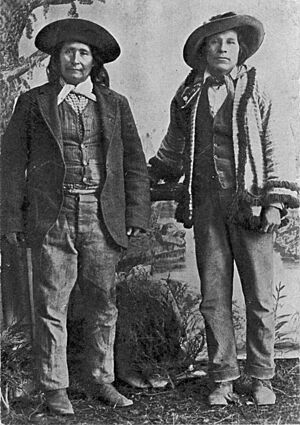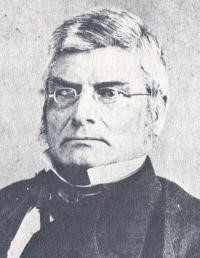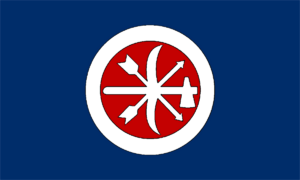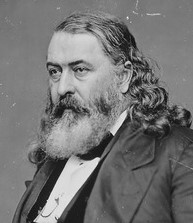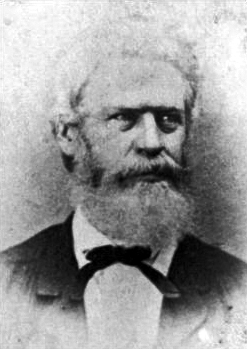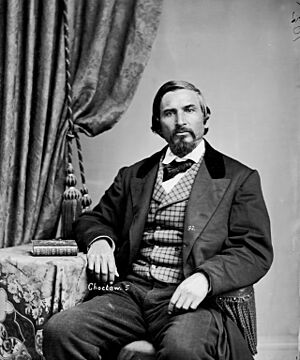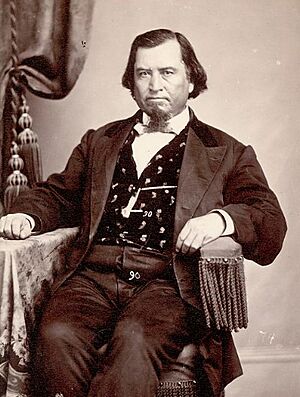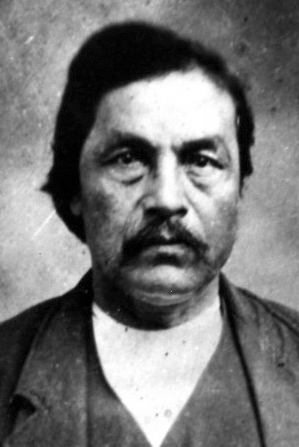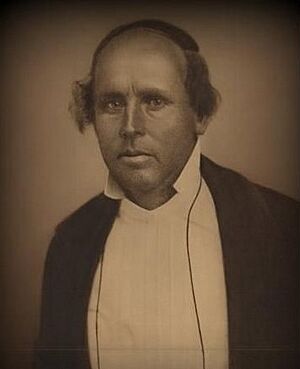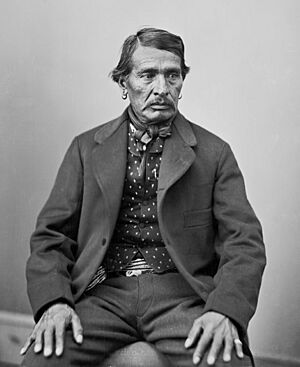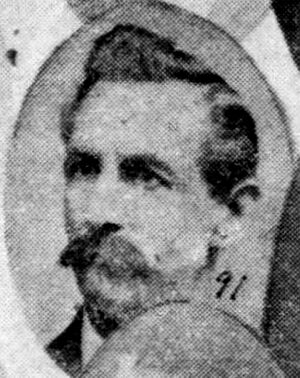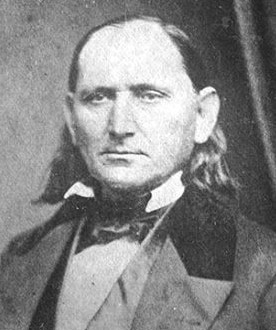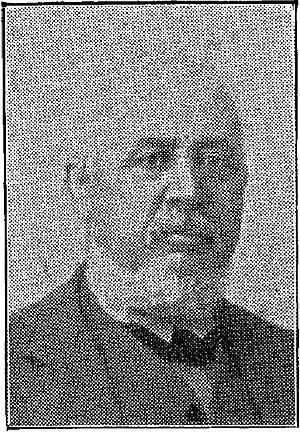Choctaw in the American Civil War facts for kids
The Choctaw people played an important part in the American Civil War. They were involved in two main areas: the Trans-Mississippi region and the Western states. The Choctaw Nation lived in the Trans-Mississippi area, which is now Oklahoma. The Mississippi Choctaw lived in the eastern state of Mississippi. Most of the Choctaw Nation had moved west before the war. But many Mississippi Choctaw stayed in their original homeland. Both groups of Choctaw people eventually joined the Confederate States of America.
The Choctaw Nation had grown strong and successful in their new western lands over 30 years. Their economy was much like the American South. It relied on enslaved people for labor. Wealthy Choctaw leaders traded cotton with cities like New Orleans. A Confederate leader named Albert Pike convinced many Native American groups to join the Confederacy. He signed treaties with them. Later, he led a group of Choctaw, Cherokee, Chickasaw, Creek, and Seminole soldiers.
The Mississippi Choctaw faced harder times. They had chosen to stay in Mississippi when most Native Americans moved west. By the time of the Civil War, the Mississippi Choctaw were very poor. They often worked as sharecroppers. Some were lucky to have white supporters who helped them. The Mississippi Choctaw often asked the U.S. government for help, but they were mostly ignored. Two wealthy white planters, John W. Pierce from Mississippi and Samuel G. Spann from Alabama, helped organize the Mississippi Choctaw. They knew the Native Americans in Mississippi well.
Contents
- Why the Choctaw Joined the Confederacy
- Choctaw in the Trans-Mississippi Theater
- First Choctaw and Chickasaw Mounted Rifles
- (Battice's) First Choctaw Battalion Cavalry
- (McCurtain's) First Choctaw Battalion Cavalry
- First Choctaw War Regiment
- First Choctaw Regiment
- Second Choctaw Regiment
- Third Choctaw Regiment
- Choctaw Warriors Regiment
- Choctaw Company
- Choctaw Infantry Company
- Indian Cavalry Division
- Unit Organization
- Battles and Skirmishes
- Choctaw in the Western Theater
- After the War
Why the Choctaw Joined the Confederacy
The Choctaw Nation moved west of the Mississippi River after the Treaty of Dancing Rabbit Creek in 1830. For 30 years, they built a successful new home. They made great progress in farming and education. Most farm work was done by enslaved people. By 1860, the Choctaw Nation lived a peaceful life. Many Choctaw citizens became successful farmers, planters, and business owners. Historian Angie Debo said their growth from 1833 to 1861 was "almost unprecedented."
"The Choctaws alone, of all the Indian nations, have remained perfectly united in their loyalty to this Government. It was said to me by more than one influential and reliable Choctaw during my sojourn in their country that not only had no member of that nation ever gone over to the enemy, but that no Indian had ever done so in whose veins coursed Choctaw blood."
Some Choctaw people became rich cotton planters and owned many enslaved people. One famous Choctaw planter was Robert M. Jones. He was part Choctaw and became a powerful politician. Jones supported the Confederacy. He became a non-voting member in the Confederacy's House of Representatives. Jones was very important in getting the Choctaw Nation to join the Confederacy.
Lincoln and Native American Issues
Abraham Lincoln saw Native American issues as less important than the growing crisis of states leaving the Union. In early 1861, Lincoln's government focused on military conflicts. They had little time for Native Americans. Lincoln and his leaders believed Native Americans were a "dying race." One U.S. senator said they were dying "through natural causes." When the Civil War started, Lincoln's government left "Indian Country." By May 1861, U.S. military posts were empty. This left tribes with "no alternative but to join the South."
Reasons for Joining the Confederacy
In February 1861, the Choctaw Nation's General Council told their leaders in Washington City to put their money in southern banks. A few days later, the council chose 12 leaders to meet with the Chickasaw. In April, Choctaw officials told Union leaders they would stay neutral. But by June 1861, the Choctaw Nation declared itself free. They then appointed leaders to make an alliance with the Confederacy.
Choctaw Nation's Reasons
Several reasons explain why the Choctaw Nation joined the Confederacy:
- They believed the United States was about to collapse.
- The United States had neglected them.
- William H. Seward, the U.S. Secretary of State, wanted to seize Native American lands.
- Their main U.S. agent supported the South.
- Their laws supported slavery.
Mississippi Choctaw's Reasons
The Mississippi Choctaw had different reasons for joining the Confederacy:
- A main reason was neglect. For decades, they asked the U.S. for help with land grants promised in the Treaty of Dancing Rabbit Creek. Many cases went unheard in U.S. courts. Some Choctaw may have joined the Confederacy hoping to solve their land problems.
- Another reason was conscription. While some volunteered, most Mississippi Choctaw soldiers were forced to join the army.
- Money incentives were also a reason. The Confederacy offered a $50 bonus to Mississippi Choctaws who joined their army.
- Some wanted prestige within their tribe. Many Native American groups honored warriors who succeeded in battle. This could lead to leadership roles.
Choctaw in the Trans-Mississippi Theater
At the start of the Civil War, Albert Pike was sent by the Confederacy to talk with Native Americans. He signed several treaties. One was the Treaty with Choctaws and Chickasaws in July 1861. This treaty had 64 terms. It covered Choctaw and Chickasaw nation independence, possible Confederate States of America citizenship, and a delegate in the Confederate House of Representatives.
Confederate army units were soon formed in Indian Territory. The Choctaws expected support from the Confederates but got little. Historian Webb Garrison wrote that Creeks, Choctaws, and Cherokees were excited to join in late 1860. But their excitement faded when they found no weapons or pay. An officer later admitted that "no tents, clothing, or camp and garrison equippage was furnished to any of them." Only the Choctaw regiment got some supplies.
First Choctaw and Chickasaw Mounted Rifles
On August 1, 1861, President Jefferson Davis was told that the First Choctaw and Chickasaw Mounted Rifles were ready. They were led by Colonel Douglas H. Cooper. The unit had six Choctaw companies, three Chickasaw companies, and one "half-breed" company.
This unit arrived late and missed the Battle of Pea Ridge. Historian Annie H. Abel wrote that the Choctaws, Chickasaws, and Creeks were "fortunate and unfortunate" to be late. They missed the fight, but also avoided the "savagery" that brought shame to their neighbors.
(Battice's) First Choctaw Battalion Cavalry
Franceway Battice (also known as Francois Baptiste or Faunceway Baptiste) became lieutenant colonel for the First Choctaw Battalion Cavalry. Simpson N. Folsom was the major. This battalion once had three companies. When it was dismissed, Battice and Folsom were given their own commands.
(McCurtain's) First Choctaw Battalion Cavalry
In 1862, Jackson F. McCurtain became the Lieutenant Colonel of McCurtain's First Choctaw Battalion. This unit was from the Choctaw Nation. The First Choctaw Battalion later became the Third Choctaw Regiment. This unit is different from the 1st Choctaw Battalion led by John W. Pierce in Mississippi.
First Choctaw War Regiment
Franceway Battice led this unit, which may have had 216 men. Battice resigned in early 1862. After he left, the battalion became the First Choctaw War Regiment.
First Choctaw Regiment
The First Choctaw Regiment was formed in early 1862. It fought in many small battles. It saw action at the first Battle of Newtonia. A total of 31 officers and 686 soldiers served until June 1865. Colonel Sampson Folsom, Lieutenant Colonel David F. Harkins, and Major Sylvester Durant were the main officers. This unit was also known by other names, like the "1st Regiment, Choctaw Mounted Rifles."
Second Choctaw Regiment
In late 1864, Colonel Simpson N. Folsom led the Second Choctaw Regiment. This unit later joined Colonel Tandy Walker's Second Indian Cavalry Brigade.
Third Choctaw Regiment
In June 1861, Jackson F. McCurtain joined the First Choctaw and Chickasaw Mounted Rifles. He became Captain of Company G under Colonel Douglas H. Cooper. In 1862, he became a Lieutenant Colonel of McCurtain's First Choctaw Battalion. This unit was from the Choctaw Nation. It was not the same as John W. Pierce's 1st Choctaw Battalion in Mississippi. McCurtain's First Choctaw Battalion was later reorganized as the Third Choctaw Regiment.
Choctaw Warriors Regiment
George E. Deneale led the Choctaw Warriors Regiment. Deneale was from Virginia and served in its government. In early 1862, he recruited about 400 Choctaws. Deneale wanted his regiment to fight in the Eastern Theater of the war. But it is unlikely they ever did.
"Tushkahoma, a Choctaw chief, is about starting for Virginia with a regiment of his people, well armed and equipped for the Confederate service. This is only one of several Choctaw regiments in the army. The Choctaws are all true and earnest in the Southern cause."
Choctaw Company
Edmund Pickens, also known as Okchantubby, was the captain of this company of Choctaws. They were likely mounted soldiers. Pickens was part Chickasaw.
Choctaw Infantry Company
John Wilkins was captain of the Choctaw Infantry Company.
Indian Cavalry Division
Brigadier General Douglas H. Cooper commanded this division. It included the First (Indian) Brigade, Second (Indian) Brigade, and other units. Brigadier General Stand Watie led the first brigade. Colonel Tandy Walker led the second. Watie's unit had Cherokee, Creek, Osage, and Seminole soldiers. Walker's unit had Choctaw, Chickasaw, and Caddo soldiers. Other parts of the division had non-Native American members.
Unit Organization
The Choctaw and Chickasaw Nations formed many companies, battalions, and regiments. The Choctaws had three units called the 1st Choctaw Battalion. Jackson F. McCurtain's unit and Franceway Battice's unit were formed in the Choctaw Nation. McCurtain's unit became the Third Choctaw Regiment. Battice's unit became the First Choctaw War Regiment. John W. Pierce's 1st Choctaw Battalion was formed in Mississippi. It fought only in Mississippi and Louisiana, not in the Trans-Mississippi Theater.
- First Choctaw and Chickasaw Mounted Rifles
* Leaders: Colonel Douglas H. Cooper, Lieutenant Colonel James Riley, Lieutenant Colonel Tandy Walker, Major Willis J. Jones, Major Mitchell LeFlore, Major Stephen Loering. * Companies: A, B, C, D, E, F, G, H, I, K. * Total: 1,400 men.
- First Choctaw Battalion Cavalry (Battice's)
* Leaders: Lieutenant Colonel Franceway Battice, Major Simpson N. Folsom.
- First Choctaw Battalion Cavalry (McCurtain's)
* Leader: Lieutenant Colonel Jackson F. McCurtain.
- First Choctaw War Regiment (formed from Battice's 1st Choctaw Battalion Cavalry)
* Leader: Lieutenant Colonel Franceway Battice.
- First Choctaw Regiment
* Leaders: Colonel Sampson Folsom, Lieutenant Colonel David F. Harkins, Major Sylvester Durant. * Companies: A, B, C, D, E, F, G, H, I, K.
- Second Choctaw Regiment (formed from Battice's 1st Choctaw Battalion Cavalry)
* Leader: Colonel Simpson N. Folsom. * Served from 1862 to June 1865.
- Third Choctaw Regiment (formed from McCurtain's 1st Choctaw Battalion Cavalry)
* Leaders: Colonel Jackson F. McCurtain, Lieutenant Colonel Tom Lewis.
- Choctaw Warriors Regiment (Deneale's Regiment)
* Leader: Colonel George E. Deneale. * Companies: A, B, C, D, E.
- Choctaw Company
* Leader: Captain Edmund Pickens.
- Wilkins' Company (Choctaw Infantry)
* Leader: Captain John Wilkins.
- Indian Cavalry Division
* Leader: Brigadier General Douglas H. Cooper. * Included: First (Indian) Brigade (led by Brigadier General Stand Watie), Second (Indian) Brigade (led by Colonel Tandy Walker), Seventh Mounted Artillery Battalion, and other units. * First Brigade had Cherokee, Creek, Osage, and Seminole soldiers. * Second Brigade had Choctaw, Chickasaw, and Caddo soldiers.
Battles and Skirmishes
Choctaw soldiers fought in many battles and small fights, including:
- Battle of Round Mountain (November 19, 1861)
- Battle of Chusto-Talasah (December 9, 1861)
- Battle of Pea Ridge (March 6–8, 1862)
- First Battle of Newtonia (September 30, 1862)
- Battle of Old Fort Wayne (October 22, 1862)
- Battle of Honey Springs (July 17, 1863)
- Battle of Perryville (Indian Territory) (August 23, 1863)
- Battle of Middle Boggy Depot (February 13, 1864)
- Battle of Poison Spring (April 18, 1864)
- Battle of Marks' Mills (April 25, 1864)
- Ambush of the steamboat J. R. Williams (June 15, 1864)
Choctaw in the Western Theater
In 1861, a Mississippi citizen tried to form a volunteer Choctaw company for the Confederacy. A newspaper, The Newton Record, reported in 1903 that "many Choctaws volunteered" in 1861.
"In 1861 a great many Choctaws volunteered for the confederate service, and served with great honor to themselves in the different commands … which operated in the southwest. They made brave soldiers and good fighters. Several of these old braves are still alive, among them being Jack Amos, the confederate scout, who now is tottering on the brink of the grave, but living in the hope that he will live and have the strength to attend the reunion in the spring at New Orleans, and for the last time to see the “Stars and Bars” float in the air in front of the survivors of his old regiment."
In summer 1862, 82 Mississippians asked Mississippi Governor John J. Pettus to force Native Americans to join the army. John Harrison, a white planter, had already enrolled about two companies of Native Americans. Harrison's companies likely joined John W. Pierce's unit. John W. Pierce and Samuel G. Spann, both white planters, organized the Mississippi Choctaw as Confederates starting in 1862.
Pierce and Spann created two separate units with some common members. Their first job was to find soldiers who had run away. Most were found in Jones County. S. G. Spann knew the Native Americans could be good scouts and use guerrilla warfare. Pierce's troops tracked runaways. But they soon fought in battles in Louisiana along the New Orleans, Jackson and Great Northern Railroad.
1st Choctaw Battalion
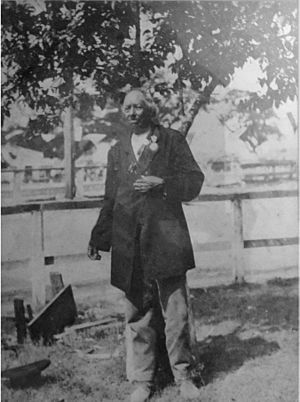
President Jefferson Davis approved the 1st Choctaw Battalion in February 1863. Major John W. Pierce led them. They were part of Lieutenant General John C. Pemberton's command. Their headquarters were at Newton Station, Mississippi. Only two companies, A and B, were formed. A total of 101 men joined in March 1863. The battalion formed in February and broke up in May 1863. Members later joined Spann's command in August 1863.
After the Chunky Creek Train Wreck in February 1863, Choctaw soldiers helped with rescue efforts. Spann wrote years later that "the passengers were rescued due to their heroic acts."
As the war continued, Native American troops went to Louisiana as backup for Colonel Horace H. Miller's command. This was in March 1863. Newspapers gave the "Indian troops" credit for pushing back the Union soldiers during the Battle of Ponchatoula. After the battle, many Native Americans left because they were not paid. During or after Grierson's Raid in April/May 1863, more Native American members of the 1st Choctaw Battalion likely ran away.
During a Union attack, white and Native American soldiers from the 1st Choctaw Battalion were captured near Ponchatoula, Louisiana. The Native American prisoners were sent by ship to Castle Williams near New York City. They were shown to New Yorkers in Madison Park for entertainment. At least two Native American prisoners died at the Union prison on Governors Island. Spann described it: "New Orleans at that time was in the hands of the Federal Gen. B.F. Butler. Without notice a reconnoitering party of the enemy raided the camp, and captured around two dozen Indians and one commissioned white officer and carried them to New Orleans. Some of the officers and several of the Indians escaped and returned to the Newton County camp; but all the balance of the captured Indians were carried to New York, and were daily paraded in the public parks as curiosities for the sport of sight-seers."
The 1st Choctaw Battalion was ordered to disband on May 9, 1863. After some members were captured on May 13, 1863, they asked government officials to transfer to Spann's Battalion of Independent Scouts.
Spann's Independent Scouts
Samuel G. Spann was a planter in Alabama when the war started. In the first year, he was a private soldier. After a year, he became an aide to General William J. Hardee. Spann was likely made a captain then.
In 1862, Spann contacted several Mississippi Choctaw settlements to recruit for his new unit. He probably met with tribal leaders. While waiting for the Native Americans to recover from measles, Spann joined Hardee's campaign into Kentucky in fall 1862. Spann fought in the Battle of Perryville.
Spann's main office was in Mobile, Alabama. He also had a recruiting camp in Newton County, Mississippi. As scouts, the Mississippi Choctaws in Spann's battalion served in the Tuscaloosa, Alabama area in fall 1863. They likely tracked people who were avoiding the draft for Brigadier General Gideon J. Pillow. Although Spann's Battalion of Independent Scouts officially disbanded on November 6, 1863, Spann continued to serve with his Choctaw soldiers.
Unit Organization
Mississippi Choctaws joined two separate battalions that had some of the same members. The 1st Choctaw Battalion was based at Newton Station, Mississippi. Spann's Independent Scouts were in Mobile, Alabama, and later Tuscaloosa, Alabama. Spann's Independent Scouts later became Alabama's 18th Confederate Cavalry. All officers were white. Native Americans served as non-commissioned officers or privates.
- 1st Choctaw Battalion (February 1863-May 1863)
* Leaders: Major John W. Pierce, Captain Nathan W. Slay, Captain Edward B. Scanlan. * Companies: A and B. * Total: 101 men.
- Spann's Independent Scouts (April 1863-November 1863)
* Leaders: Major Samuel G. Spann, Lieutenant Edward M. Keith, Captain John C. Ransom, Captain William H. Jemison. * Companies: A, B, C, D.
- Alabama's 18th Confederate Cavalry (November 1863-June 1865)
* Leader: Major Samuel G. Spann. * Companies: Two companies (Captain John C. Moore and Captain John G. Harrison).
Battles and Actions
Mississippi Choctaw soldiers participated in:
- Rescue & Recovery at the Chunky Creek (February 19, 1863)
- Battle of Ponchatoula (March 24–26, 1863)
- Conscription Operations (September–November, 1863)
After the War
After years of fighting, the Choctaws in the Trans-Mississippi Theater became tired. Their support for the Confederacy weakened. Lieutenant Colonel Jackson F. McCurtain feared a split in the nation. He wrote to Brigadier General John McNeil hoping for peace. McCurtain felt it would be hard to get all Choctaws to surrender at once. But he believed it could happen with time.
However, the Choctaw Nation was still loyal to the Confederacy. A few citizens became loyal to the Union and chose a new governor. They wanted the U.S. government to recognize them. But the Union would not, because the nation was "still rebel." The Choctaws continued to support the Confederacy until it collapsed.
Trans-Mississippi Theater Aftermath
On June 19, 1865, Principal Chief Peter P. Pitchlynn surrendered the military at Doaksville, Choctaw Nation. The Choctaws put down their weapons. The Union took control of the territory until a formal peace treaty was signed.
The next spring, a Reconstruction treaty was made by the United States. The 1866 Treaty with the Choctaw and Chickasaw had 51 articles. Some important parts included:
- A declaration of lasting peace.
- Forgiveness for siding with the Confederacy.
- The end of slavery.
The Choctaw leaders who signed the treaty included Campbell LeFlore, John Page, James Riley, Alfred Wade, and Allen Wright. Peter P. Pitchlynn and Douglas H. Cooper were also there. The treaty was announced in July 1866.
Western Theater Aftermath
In Meridian, Mississippi, and Tuscaloosa, Alabama, the Native American Confederates surrendered. They had served the Confederacy for several years. Some may have served as early as 1861. Jack Amos, in his Mississippi pension, said he first joined in April 1861. The last Native American Confederates surrendered in May 1865.
Decades after the war, many Confederate veterans formed groups called U.C.V. camps. Spann was chosen to lead U.C.V. Camp Dabney H. Maury in Newton, Mississippi. John Blakeley, who was a white teenager during the war, became the camp's helper. He wrote about the Choctaw soldiers.
Blakeley wrote in The Meridian Press about the few surviving Native American members of Camp Maury. He wrote: "On the first Saturday in February, 1901, Camp No. 1312 was organized with ... nineteen Indian braves ... If there is enough interest yet felt by our people for these unfortunate and only genuine Americans yet remaining in Mississippi and of noble record, will it be too much to ask you to please hand this to your excellent paper, the Press, and send a copy of it to Camp Dabney H. Maury."
The veterans attended many national reunions. In 1903, Spann and some Native American veterans went to the New Orleans reunion. There, Jack Amos was interviewed by a journalist.
"FAMOUS INDIAN SCOUT ... Jack Amos of the Choctaw Tribe is Here. One of the Heroic Red Men of the Stormy Period. First With Pearce, and Later With Spann's Battalion. Mississippi Is Planning to Honor the Indian ... He is of the Choctaw tribe, and belonged to a heroic band of red men who gave splendid aid to the Confederacy, and who suffered much as a result of their loyalty to the Southern cause. Amos is now a citizen of Mississippi, and has resided in that State since the war. He is an attractive figure among the reunion visitors, and, while well advanced in years, is entering into the spirit of the occasion with a fine enthusiasm. He is a full-blooded Choctaw Indian, and is a native of Mississippi. Amos is now seventy-three years old. He talks well of himself and of the part he and other Indians played in the war."
Jack Amos died a few years later in 1906.
Reconstruction
Reconstruction was very hard for the Native American nations west of the Mississippi. The Choctaw Nation faced big problems. They lost huge amounts of land. Many freedmen (formerly enslaved people) moved into their territory without limits. And their independent tribal government ended.
Soon after slavery ended, the Choctaw Freedmen were "homeless and penniless." Very few could read or write. This made them "helpless and dependent."
Commemoration
U.C.V. Camp Dabney H. Maury planned to build a monument for the Mississippi Choctaws' role in the Civil War. For unknown reasons, this did not happen. But state markers were placed in many historic areas decades later.
|


